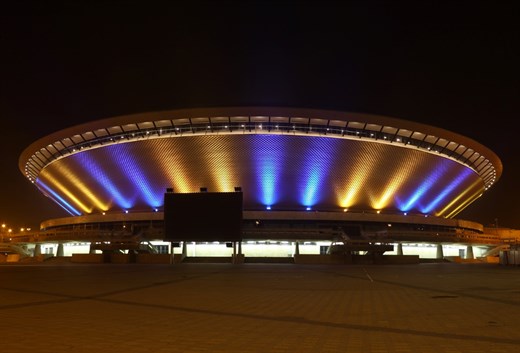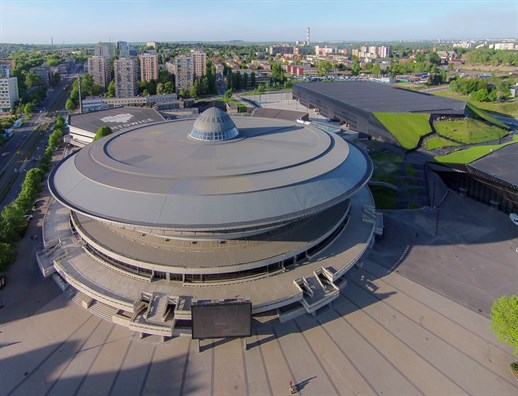Information
Tournament Format
The teams play a single round-robin series. Each teams plays each opponent once. The first two winning teams of the event will be promoted to the Top Division. The last-ranked team will be relegated to Division I Group B.
Note: If the co-hosts for the 2017 IIHF Ice Hockey World Championship (Germany and France) end up in positions 7 and 8 in Group A during the 2016 IIHF Ice Hockey World Championship, only the winner of the 2016 IIHF Ice Hockey World Championship Division I Group A will be promoted and only one team will be relegated from the top division.
Three Point System
For all games points shall be awarded as follows:
- 3 points for the winning team at the conclusion of regulation time
- 1 point for both teams at the conclusion of regulation time if the game is tied
- An additional point earned for the team winning the game in a 5-minute overtime period, or the Game Winning Shots Procedure if the teams are still tied following conclusion of the overtime period
- 0 points for the team losing the game in regulation time
Overtime Operations
If a game is tied at the end of regulation time, a five-minute overtime period shall be played immediately after an intermission of three minutes. Teams will change ends for the overtime period. The game will end when the five minutes has expired or when a goal is scored; the scoring team will be declared the winner. If no goal is scored in the overtime period then the Game Winning Shots Procedure will apply. All overtime periods of any IIHF game shall be played with each team at the numerical strength of four (4) skaters and one (1) goalkeeper.
Game Winning Shots Procedure
If no goal is scored in the overtime period then the Game Winning Shots (GWS) procedure will apply. The following procedure will be utilized:
-
Shots will be taken at both ends of the ice surface. The 14-meter wide longitudinal centre section of the rink, between the Face-Off Spots in the neutral and end zones, will be dry-scraped by the ice-resurfacing machine prior to the Game Winning Shots during the time required to organize the program accordingly.
-
The procedure will begin with three different shooters from each team taking alternate shots. The players do not need to be named beforehand. Eligible to participate in the Game Winning Shots will be the four goalkeepers and all players from both teams listed on the official game sheet except as specified in article 3 below.
-
Any player whose penalty had not been completed when the overtime period ended is not eligible to be one of the players selected to take the shots and must remain in the penalty box or in the dressing room. Also players serving penalties imposed during the game winning shots must remain in the penalty box or in the dressing room until the end of the procedure.
-
The Referee will call the two captains to the Referee Crease and flip a coin to determine which team takes the first shot. The winner of the coin toss will have the choice whether his team will shoot first or second.
-
The goalkeepers shall defend the same goal as in the overtime period and may remain at their goal creases while the opposing team is taking a shot.
-
The goalkeepers from each team may be changed after each shot.
-
The shots will be taken in accordance with rule 509 of the IIHF Official Rule Book.
-
The players of both teams will take the shots alternately until a decisive goal is scored. The remaining shots will not be taken.
-
If the result is still tied after 3 shots by each team the procedure shall continue with a tie-break shoot-out by one player of each team, with the same or new players with the other team starting to take the tie-break shots. The same player can also be used for each shot by a team in the tie-break shoot-out. The game shall be finished as soon as a duel of two players brings the decisive result.
-
The Official Scorekeeper will record all shots taken, indicating the players, goalkeepers and goals scored.
-
Only the decisive goal will count in the result of the game. It shall be credited to the player who scored and to the goalkeeper concerned.
-
If a team declines to participate in the game winning shots procedure the game will be declared as a loss for that team and the other team will be awarded 3 points for a win. If a player declines to take a shot it will be declared "no score" for his team.
Tie breaking formula
The tie-breaking system for two teams with the same number of points in a standing will be the game between the two teams, the winner of the game taking precedence.
Due to the fact that the three-point system does not allow a game to end in a tie, then the following tie breaking procedure is applicable when three or more teams are tied in points in a Championship standing.
Should three or more teams be tied on points, then a tie breaking formula will be applied as follows, creating a sub-group amongst the tied teams. This process will continue until only two or none of the teams remain tied. In the case of two tied teams remaining, the game between the two would then be the determining tie-breaker as the game could not end as a tie. In the case of none of the teams being tied, the criteria specified in the respective step applies.
Step 1:
Taking into consideration the games between each of the tied teams, a sub-group is created applying the points awarded in the direct games amongst the tied teams from which the teams are then ranked accordingly.
Step 2:
Should three or more teams still remain tied in points then the better goal difference in the direct games amongst the tied teams will be decisive.
Step 3:
Should three or more teams still remain tied in points and goal difference then the highest number of goals scored by these teams in their direct games will be decisive
Step 4:
Should three or more teams still remain tied in points, goal difference and goals scored then the results between each of the three teams and the closest best-ranked team outside the sub-group will be applied. In this case the tied team with the best result (1. points, 2. goal difference, 3. more goals scored) against the closest best ranked-team will take precedence
Step 5:
Should the teams still remain tied, then the results between each of the three teams and the next highest best-ranked team outside the sub-group will be applied.
Step 6:
Should the teams still remain tied after these five steps have been exercised then Sport considerations will be applied and the teams will be ranked by their positions coming into the Championship (seeding).
Note: If not all mutual games have been played yet in an ongoing tournament, the tied teams will be ranked in the standings according to the following criteria: 1. Lower number of games played, 2. Goal difference, 3. Goals scored, 4. Positions coming into the Championship.
More information
Click here to download the IIHF’s Rule Book and Sport Regulations.
Player Entry
Teams can have up to 22 players on their rosters at the 2016 IIHF Ice Hockey World Championship Division I Group A.
- The teams submit the names of the participating players at the first Championship Directorate.
- The maximum number of players allowed on a Team Registration Form at the beginning of the World Championship is 20 skaters and 2 goalies. The minimum is 15 skaters and 2 goalies.
- At the first Directorate meeting, the teams must name at least the minimum number of 15 skaters and 2 goalkeepers. The players entered must be present at the championship venue by the time of the Directorate meeting.
- The remaining players up to the allowed maximum of 20 + 2 must be submitted for players' control two hours before any of the following championship games. Players can be added throughout the tournament until the roster is full.
- During a game, a team may enter (dress) 20 skaters and 2 goalkeepers on the Official Game Sheet, with the emergency goalkeeper standing by if a goalie entered to the Official Game Sheet is unable to play.
Eligibility
To play in the IIHF World Championship, the Olympic ice hockey tournament and the qualifications to these competitions, players must fulfill the following qualification requirements:
- Each player must be under the jurisdiction of an IIHF member national association
- Each player must be a citizen of the country he represents.
Acquiring a new national eligibility (The ‘two-year’ case)
When a player has changed his citizenship or has acquired another citizenship and wants to participate for the first time in an IIHF competition representing his new country he must:
- Prove that he has participated for at least two consecutive hockey seasons and 16 consecutive months (480 days) in the national competitions of his new country after his 10th birthday during which period he has neither transferred to another country nor played ice hockey within any other country.
- Have an international transfer card (ITC) that shows the transfer to the national competition of his new country and which was approved and dated at least 16 months (480 days) prior to his proposed participation.
Change of national eligibility (The ‘four-year’ case)
A player, who has previously participated in IIHF competition, can switch national eligibility (but only once in a player's life) if:
- He is a citizen of the new country of his choice.
- He has participated for at least four consecutive years (1460 days) in the national competitions of his new country, during which period he has neither transferred to another country nor played ice hockey within any other country and has not played for his previous country in an IIHF competition during this four year period.
- He has an international transfer card (ITC) that shows the transfer to the national competition of his new country and which was approved and dated at least four years before the start of the IIHF competition in which he wishes to participate.
Katowice – for a change
Katowice is one of the fastest-developing cities in Poland. It’s the capital of the Silesian region, the centre of more than two million people and the heart of Silesia well-connected with other parts of Poland, Europe and the world. Within less than one hour you can get here from the airports in Katowice, Krakow and Ostrava. The city of Katowice is promoted by the slogan “Katowice – for a change” because of the current development in the urban and cultural areas and the labour market.
“Katowice – for a change” confirms the belief that Katowice is a city which is worth your attention because of its avant-garde and innovative aspects. Katowice is a city where new music (OFF Festival Katowice, Tauron New Music) appears in the vicinity of avant-garde plastic forms (Katowice Street Art Festival, Silesian design) and architectural forms (Spodek, Silesian Museum situated in a former coal mine, Polish National Radio Symphony Orchestra and Convention Bureau).
More information: www.katowice.eu

Arena
Spodek is a multipurpose venue in Katowice, which was opened in 1971 and is located at avenue Korfantego 35 of the city centre.
Spodek is the most recognizable building in the capital of Silesia. The building was completed in 1971 but because of the modernization it’s still one of the most modern arenas in Poland. However, the greatest virtue of Spodek is the best and unique atmosphere which guarantees positive emotions.
The arena includes a gym, an ice rink, a hotel and three car parks. It is the second-biggest indoor venue of its kind in Poland after Krakow Arena. The total Spodek capacity is 9,000 people.
It hosted many important sporting events such as the 1976 IIHF Ice Hockey World Championship during which the host team spectacularly beat defending champion USSR and the 2014 FIVB Volleyball Men's World Championship.
Not only sports events are popular at the venue but also music concerts, cultural and business events. During the last few years Spodek held Electronic Sports League tournaments like ESL One Katowice 2015, IEM Season IX - Katowice or Rawa Blues Festival.
Its Polish name Spodek refers to a flying saucer (its shape resembles a UFO). Spodek is a major contributor to the cultural significance of Katowice in Poland especially for the younger generations. It has also been used as an unofficial symbol for the city on posters promoting redevelopment in Katowice.
Spodek is home to GKS Katowice ice hockey club during the winter months.

Spodek is located in the city centre, near Rondo Gen. Jerzy Zietek, linking the national route No. 79 with Korfanty Avenue.
Spodek is accessible by car and also by public transportation:
- 45 minutes from the airport Katowice Pyrzowice,
- 3 minutes from the railway station Katowice by tram no. 11 or 14 (tram stop at the roundabout)
- 10-minute walk from the railway and bus station
More information: www.spodek.eu (in Polish)

TV Listings
The 2016 IIHF Ice Hockey World Championship Division I Group A will be broadcast in following countries:
-
Austria: ORF
-
Bosnia & Herzegovina: TV Arenasport
-
Croatia: TV Arenasport
-
Korea: SBS ESPN
-
Macedonia: TV Arenasport
-
Montenegro: TV Arenasport
-
Poland: TVP
-
Serbia: TV Arenasport
-
Slovenia: Sport TV, Radio Slovenia
Media Accreditation
Media accreditation for the 2016 IIHF Ice Hockey World Championship Division I Group A in Katowice can be requested until 3rd April.
Please complete the application form and send it to [email protected]. TV, radio and websites who wish to publish video/audio content please contact [email protected].



















































